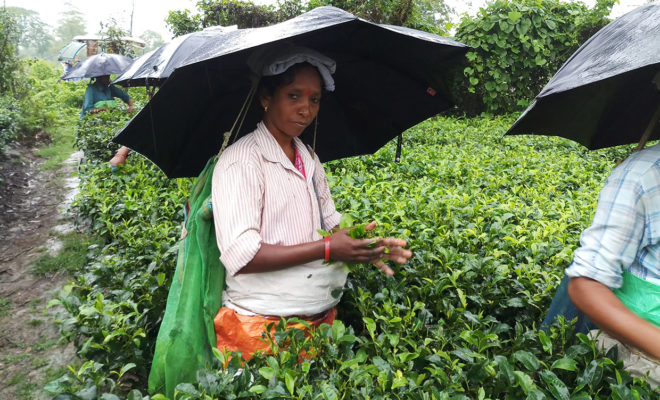Business
Darjeeling’s Tea Gardens Limp Back

Workers in Darjeeling tea estate.
Photo: G Singh
The labor standoff over wages of tea workers is crippling the world famous Darjeeling tea industry.
A year after labor conflicts and strikes paralyzed the industry, the tea gardens of Darjeeling are limping back to normalcy.
Nearly 8.5 million kilograms of tea is produced in 87 tea gardens of Darjeeling annually. It had fallen to paltry 2.8 million kg in 2017. Nearly 80 percent is exported to countries like Japan, Germany, USA, UK, France and Russia, among others. In 2018, nearly 6 million kg of Darjeeling tea was exported.
The 2017 labor shutdown had whiplashed the second flush, considered most important in terms of quality and export, “The timing of the agitation couldn’t have been worse as it coincided with the second flush, which is mostly exported because of its quality. It was the first time that tea gardens in the hills were included in the agitation. As a result, the tea industry faced disastrous consequences,” said Subrata Bose, a small tea grower based in Siliguri. “The first and second flush are considered premium, contributing about 45 percent of the annual production and the tea produced in these seasons is mostly exported.”
Industry insiders say it will take a few years to fully recover from the shutdown. The unrest provided a fertile ground for other tea growing regions, especially Nepal, to make a play for importers of the world famed brew.
Kaushik Basu, Secretary of Darjeeling Tea Association, said: “It cannot be ruled out that Darjeeling tea suffered immensely because of the strike. It created apprehension in the minds of buyers who fear the re-run of the situation. They even begun to buy tea from alternative markets of Nepal and other countries,” said.
Tea marketers from Japan, which imports 2 million kg of the Darjeeling tea every year, tapped tea from Nepal tea growers in 2017. “The situation made the buyers jittery and the demand came down by 10-12 percent as compared to other years. Sadly, neither the state nor the Central government came up to iron out the doubts in the minds of the buyers. It could take at least 3-5 years for the situation to turn normal only if no further strike occurs,” Base said.
Nepal tea enters India through the Indo-Nepal Free Trade Agreement free trade agreement. The agreement was extended for another seven years in 2016.
Nepal’s tea gardens, spread across 28,000 hectares, mostly in the east, are gradually expanding to the central and western parts of the country. These tea gardens produce over 24 million kgs of tea per year, of which around 6 million kg is orthodox, just shy of the 8 million kg of orthodox tea produced in Darjeeling.
According to industry analysts, the Darjeeling tea industry loses Rs 120 crore every year to cheap leaf tea imported from Nepal under the rubric of “Darjeeling tea.”

Plucking tea in a tea estate in Darjeeling. Photo: G Singh
The tea gardens are also skrinking. “The hills are losing tea plantations areas to encroachments and increasing population. Several decades ago, Darjeeling produced around 20 million kg of team which has come down to just over 8 million kg on an average. It is becoming difficult to compete with other tea growing countries,” said a prominent tea grower on condition of anonymity.
Sumon Majumder, the general manager at Darjeeling Impex Limited, one of the leading tea exporters in the eastern India is counting on 2019 as the year the Darjeeling tea industry rebounds: “The pruning has been good this year (2018) and the climatic conditions are also favorable because of chilling cold which helps in improving its quality. We sincerely hope that the quality of first flush will be really good that would translate into higher returns. The exports are likely to pick up, because of good quality and increased production.”
But the 2017 shutdown was a body blow to the industry, he says: “There was 5.6 percent growth in the export of tea starting 2017. The future looked bright but then came the near four-month shutdown in the hills in demand of Gorkhaland that virtually destroyed everything, because it was time for second flush considered the most profitable produce. We are still trying to recover as our export of Darjeeling tea fell down to Rs 7 crore in 2018 from around Rs 10 cr in 2016. Apart from monetary loss, it generated fear in the minds of the international buyers forcing them to stay away from buying Darjeeling tea.”
Tea growers are apprehensive over union demands for wage hikes.
In August 2018, a three-day strike was called in 196 gardens of Terai and Dooars by the joint forum of 23 trade unions demanding revision of minimum wages. The two regions accounted for more than a quarter of the country’s tea production in 2017.

Sumon Majumder, the general manager at Darjeeling Impex Limited: “Apart from monetary loss, it (the shutdown) generated fear in the minds of the international buyers forcing them to stay away from buying Darjeeling tea.” Photo: G Singh
The trade unions are gearing up for a movement for wage hike in wages. Abhijit Mazumder, the president of Terrai Sangrami Chai Mazdur Union based in Siliguri, said: “The state government has been playing in the hands of the employers and they have been dilly-dallying on our demand to raise the wages of the laborers.”
Mazumder said the union is planning a new agitation: “We have been raising our voice for over four year for hike of wages but to no avail. We have been demanding that wages to be increased to Rs 400-Rs 450 from Rs 159 being paid to the workers. The onus should not only be on the workers, but also on the employees who are exploiting them. The workers have also tried to produce best quality of tea, but have got nothing in return.”
Harkaram Chaudhary, superintendent manager of Namring Tea Estate in Darjeeling, expressed apprehension about the rising risks to Darjeeling tea: “The quality of tea is getting affected, because of increasing tea plucking rounds from seven to 10-12 days due to severe labor shortage. The long plucking rounds have been impacting the quality of the tea. We export around 250 kg of Oolong tea of the 300 kg produced. Climate change is also the reason as erratic weather has changed the texture of the leaves and bushes have become dormant.”
India is home to a wide variety of teas, including black tea, orthodox tea, green tea and organic tea. Unlike many other tea producing and exporting nations, India has a manufacturing base for both CTC, or black tea, and orthodox tea, in addition to green tea. India offers several high-quality specialty teas, such as Darjeeling, Assam Orthodox and the high- range Nilgiri, which has a distinctive aroma, strength, color and flavor.
“The brew is known for its aroma and flavor and is sought after the tea lovers across the world. It will continue to remain the favorite cuppa for us no matter what comes. The strike is over and buyers are coming back and they are aware that it is now also happening in other countries. We expect the current year to bring higher returns for the tea industry,” said S. Patra, the secretary of Indian Tea Association.
Second Largest Tea Producer in the World
India is the world’s second largest tea producer and fourth largest exporter after Kenya, China and Sri Lanka.
India’s tea exports stood at US$ 837.33 million in 2017-18, as compared to US$ 731.25 million the previous year, according to the Tea Board of India.
In the first six months of the current financial year, April-Oct 2018, tea exports had touched US$ 463.95 million. During this time, major importers of Indian tea were Russia ($ 64.14 million), Iran ($ 57.63 million), US ($ 34.90 million), UK ($ 34.31 million) and UAE ($ 30.15 million).



